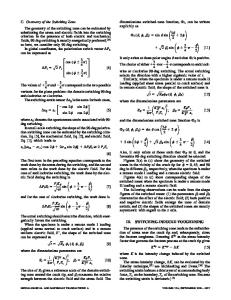Domain switch toughening in polycrystalline ferroelectrics
- PDF / 133,605 Bytes
- 8 Pages / 612 x 792 pts (letter) Page_size
- 89 Downloads / 327 Views
Mode I steady crack growth was analyzed to determine the toughening due to domain switching in ferroelectric ceramics. A multi-axial, electromechanically coupled, incremental constitutive theory is applied to model the material behavior of the ferroelectric ceramic. The constitutive law is then implemented within the finite element method to study steady crack growth. The effects of mechanical and electrical poling on the fracture toughness are investigated. Results for the predicted fracture toughness, remanent strain distributions, and domain switching zone shapes and sizes are presented. Finally, the model predictions are discussed in comparison discrete switching models and to experimental observations. I. INTRODUCTION
This paper was presented at the Spring meeting of the Materials Research Society on March 29, 2005 in San Francisco, CA. To place new results in the appropriate context, previously published results are reviewed and cited accordingly. Ferroelectric ceramics have large electromechanical coupling effects and hence are widely used in smart structure applications. Since these devices often operate under strong mechanical and electrical loading conditions, the brittle ferroelectric material can be susceptible to fracture. Therefore, an understanding of ferroelectric fracture is a key issue for the efficient and reliable design of these devices. There have been numerous experimental investigations on the fracture toughness of ferroelectric ceramics,1–8 and it is commonly accepted that domain switching leads to increased toughening and Rcurve behavior in these materials. It is also well known that both electric field and mechanical stress drive the domain switching process, and hence fracture in ferroelectrics is inherently a coupled electromechanical process. This paper presents a collection of simulation results on the toughening behavior of ferroelectrics undergoing steady crack growth. The unifying feature of these results is the phenomenological constitutive law that is used to represent the electromechanical material response. This constitutive model is incorporated within a steady-state finite element method to determine the domain switch
toughening for unpoled, mechanically poled, and electrically poled materials. II. PHENOMENOLOGICAL CONSTITUTIVE MODEL
The goal of any phenomenological constitutive theory is to provide a relatively simple framework within which the laws of thermodynamics are satisfied and a wide range of material behaviors can be represented. A summary of the recent developments on microelectromechanical and phenomenological constitutive modeling of ferroelectrics can be found in review articles by Kamlah9 and Landis.10 The phenomenological constitutive model presented below is based on the work of Landis and co-workers,11–13 and additional details of the model can be found in those references. This constitutive model has been verified against experimental observations and micro-electromechanical self-consistent simulations based on the model of Huber et al.14 For simplicity, i
Data Loading...











